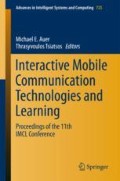Abstract
This research attempts to build a multiple linear regression model to predict the marks of students. As a case study, the course M359 – Relational Database offered to undergraduate students of Arab Open University, Oman is taken. The model is trained using the different assessment marks of students in blended learning mode of the above course. Separate models were built based on the gender. Same datasets were used for training and testing purposes. The open source statistical software gretl was used to build and test the model. The study found that the model generated for male category shows more correlation in the process of prediction than the female category. The findings of the research suggest that it is challenging to build a prediction model for students in blended learning environment.
Access this chapter
Tax calculation will be finalised at checkout
Purchases are for personal use only
References
Gadhavi, M., Patel, C.: Student final grade prediction based on linear regression. Indian J. Comput. Sci. Eng. 8(3), 274–279 (2017)
Kaur, P., Singh, W.: Implementation of student SGPA prediction system (SSPS) using optimal selection of classification algorithm. In: 2016 International Conference on Inventive Computation Technologies (ICICT), vol. 2, p. 18, August 2016
Comendador, B.E.V., Rabago, L.W., Tanguilig, B.T.: An educational model based on knowledge discovery in databases (KDD) to predict learner’s behavior using classification techniques. In: 2016 IEEE International Conference on Signal Processing, Communications and Computing (ICSPCC), p. 16, August 2016
Devasia, T., Vinushree, T.P., Hegde, V.: Prediction of students performance using educational data mining. In: 2016 International Conference on Data Mining and Advanced Computing (SAPIENCE), pp. 91–95, March 2016
Zvacek, S.M., de Ftima Chouzal, M., Restivo, M.T.: Accuracy of self-assessment among graduate students in mechanical engineering. In: 2015 International Conference on Interactive Collaborative Learning (ICL), pp. 1130–1133, September 2015
Kaur, K., Kaur, K.: Analyzing the effect of difficulty level of a course on students performance prediction using data mining. In: 2015 1st International Conference on Next Generation Computing Technologies (NGCT), pp. 756–761, September 2015
Sorour, S.E., Mine, T., Goda, K., Hirokawa, S.: Predicting students’ grades based on free style comments data by artificial neural network. In: 2014 IEEE Frontiers in Education Conference (FIE) Proceedings, p. 19, October 2014
Taruna, S., Pandey, M.: An empirical analysis of classification techniques for predicting academic performance. In: 2014 IEEE International Advance Computing Conference (IACC), pp. 523–528, Febuary 2014
Watson, C., Li, F.W.B., Godwin, J.L.: Predicting performance in an introductory programming course by logging and analyzing student programming behavior. In: 2013 IEEE 13th International Conference on Advanced Learning Technologies, pp. 319–323, July 2013
Babyak, M.A.: What you see may not be what you get: a brief, nontechnical introduction to overfitting in regression-type models. Psychosom. Med. 66(3), 411–421 (2004)
Farrar, D.E., Glauber, R.R.: Multicollinearity in regression analysis: the problem revisited. Rev. Econ. Stat. 49(1), 92–107 (1967). https://doi.org/10.2307/1937887
Author information
Authors and Affiliations
Corresponding author
Editor information
Editors and Affiliations
Rights and permissions
Copyright information
© 2018 Springer International Publishing AG, a part of Springer Nature
About this paper
Cite this paper
Sherimon, V., Puliprathu Cherian, S. (2018). Building a Multiple Linear Regression Model to Predict Students’ Marks in a Blended Learning Environment. In: Auer, M., Tsiatsos, T. (eds) Interactive Mobile Communication Technologies and Learning. IMCL 2017. Advances in Intelligent Systems and Computing, vol 725. Springer, Cham. https://doi.org/10.1007/978-3-319-75175-7_88
Download citation
DOI: https://doi.org/10.1007/978-3-319-75175-7_88
Published:
Publisher Name: Springer, Cham
Print ISBN: 978-3-319-75174-0
Online ISBN: 978-3-319-75175-7
eBook Packages: EngineeringEngineering (R0)

